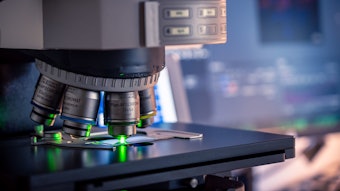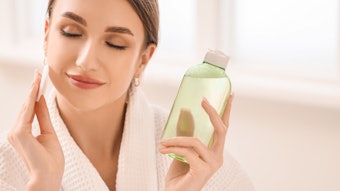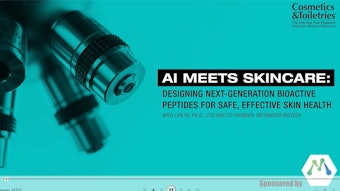
Editor's note: The "Words from Wiechers" article series considers the lessons our industry can learn from the late Johann Wiechers, Ph.D. He was an advisor, colleague and insightful leader in the industry until his unexpected passing. Presenting Wiechers's insights is Anthony J. O'Lenick, Jr.
This month, we review Chapter 43 of Wiechers's book, Memories of a Cosmetically Disturbed Mind. Here, he reminds us to step back and do the science correctly, ensuring we understand it, before turning public opinion against it; the case of aquaporins is given as an example.
Everything Moisturizes
As O'Lenick writes, in this chapter, Wiechers says: "Everybody recognizes the need for moisturizing [their] skin. But at the same time, almost every chemical that I have measured in my cosmetic life turned out to be moisturizing [to the] human skin. Maybe I was lucky, maybe I was smart and only picked good moisturizing molecules to measure, but I often jokingly said that if I would grind up the hard disc of my computer, even that would moisturize my skin. From this, you could conclude that moisturizing human skin would and should be easy.
"That was exactly one of my problems when I wanted to select my benchmark chemicals, [i.e.], a positive and a negative control for skin moisturization. As everything moisturizes human skin, what do you select as the negative control? The only thing needing moisturization was human skin itself, so I chose untreated skin as a negative control and glycerin as a positive control. I applied a product and expressed the result of that as a relative performance moisturization (RPM), where untreated skin had value of 0% and glycerin-treated skin a value of 100%. Measured at 6 hours, the worst moisturizer of all chemicals tested turned out to be water!
"Water and glycerin are interesting molecules if you talk about skin moisturization. We have buckets full of water within our bodies that stay inside our body thanks to an efficient barrier called the stratum corneum. But the barrier itself dries out toward the surface as the environment is significantly less moist than the inside of our bodies. We keep it moisturized via the production of the natural moisturizing factor (NMF), which is a mixture of amino acids, urea, lactate and other polar hygroscopic molecules. One of the most hygroscopic molecules is glycerin but that is not part of the NMF. This is something we apply in large quantities in cosmetic products to give back to our skin its youthful appearance and allow it to be flexible. We have to apply it from the outside as there is no 'natural' glycerin present within the skin"—or at least, that was the belief.
The Case of Aquaporins
Wiechers continues, "That is what we thought until we realized that the phospholipids that are present in the cell membranes of actively proliferating keratinocytes are broken down during the transformation of these cells to terminally differentiated keratinocytes and glycerin is left over. This glycerin will penetrate into the cells and act as a skin moisturizer. But what regulates the uptake of glycerin into cells? Aquaporins.
"Aquaporins is a word that is underlined with red wriggles in my Word documents. Bill Gates therefore does not know what it means; and with him, many consumers of cosmetic products. It might be even new for you but you are excused. In the second edition of Dry Skin and Moisturizers–Chemistry and Function of Marie Lodén and Howard Maibach, published in 2006, there are only two references in the index to aquaporin-3, the epidermal water/glycerol transporter. In a very recent article in the Journal of Investigative Dermatology by Mariko Hara-Chikuma and Alan S. Verkman, ... aquaporin-3 (AQP-3) is being reviewed and we learn that it is involved in skin hydration, wound healing and skin tumorigenesis.
"By comparing skin hydration levels of normal mice and AQP-3 knockout mice, it is obvious that the skin of mice lacking AQP-3 is very dry and not elastic. Interestingly, if you measure the level of glycerin, also, these levels are significantly reduced in the absence of AQP-3. In short, AQP-3 is good for you and we have seen the emergence of new cosmetic ingredients that that stimulate AQP-3 expression, which (should) result in more skin hydration.
'By coming out too early with nonsense claims, we run the risk of missing out on great product opportunities as we will have turned the public opinion against a new technology before we even mastered it.'
"In wound healing, it was observed that wounds in AQP-3-deficient mice healed significantly slower due to the role of AQP-3 in the proliferation of keratinocytes during wound healing; but its involvement in skin tumorigenesis is the one that makes you raise your eyebrows. It was shown that AQP-3 was strongly over-expressed in basal cells in human skin squamous cell carcinomas. Moreover, AQP-3 knockout mice do not develop skin tumors following exposure to a tumor initiator and phorbol ester promoter, a well-established multistage carcinogenesis model.
"Subsequently, in May 2008, Alan Verkman published, 'A Cautionary Note on Cosmetics Containing Ingredients that Increase Aquaporin-3 Expression' in Experimental Dermatology in which he states, 'Though the available data show prevention of skin tumorigenesis with AQP-3 deletion, it is not unreasonable to postulate an increased propensity for tumor formation when AQP-3 expression is up-regulated. Further studies are thus indicated in testing the relation between epidermal AQP-3 up-regulation and skin tumorigenesis as well as epidemiological evaluation of the incidence of squamous cell carcinomas and other skin cancers in subjects using cosmetics containing AQP-3 expression-enhancing ingredients.'
"While Verkman is right in what he says, we are dealing here of course with the famous question of what was first, the chicken or the egg. If there is more AQP-3 in basal squamous cell carcinoma, this does not automatically mean that increased AQP-3 levels lead to basal squamous cell carcinoma. Every cow is an animal but not every animal is a cow. Having money makes many people happy, but that does not mean that you can only be happy if you have money.
"Squamous cell carcinoma is associated with increased AQP-3 but that does not automatically mean that increased AQP-3 leads to more squamous cell carcinoma. It could, [though], as Verkman says, and therefore we agree that we need to be careful and investigate. He then continues, 'Perhaps, cosmetic testing in animals, which has fallen into disfavor among cosmetic companies and regulatory agencies, should be reinstituted at least in selected cases such as this.' Although very controversial, I prefer this reaction over the advertisement that I saw for a product on the internet as a moisturizer that allows the body to produce approximately 50% less AQP-3. (Claiming that it makes your skin more resistant against cancer would clearly be medical claim, but I wonder how well this moisturizer moisturizes human skin).
"Let’s do our science properly and completely before we come up with new claims and completely confuse ourselves, our regulatory bodies and our consumers. By coming out too early with nonsense claims, we run the risk of missing out on great product opportunities as we will have turned the public opinion against a new technology before we even mastered it—as is happening right now with nanotechnology. Will we ever learn to keep our mouths shut while we do our investigations? That question, right now, is equally difficult to answer as [to] whether down- or up-regulation of aquaporins leads to dry skin or skin cancer; but those questions definitely need a technical answer before our marketers get involved."
The Lesson
O'Lenick continues: Johann addresses "claims" that either are not provable or of no importance. It is rather like having a great compound and looking for a disease that it may cure; or more properly, having a compound looking for a cosmetic claim to which we can apply it. Johann is correct, this approach ruins our credibility.
Another problem is claims made with no supporting data and no accepted definition of terms. How many claims to biodegradability or sustainability have we seen that neither present data nor define the test methodology used for many buzz word attributes.
As Johann says, “Will we ever learn to keep our mouths shut while we do our investigations?”









